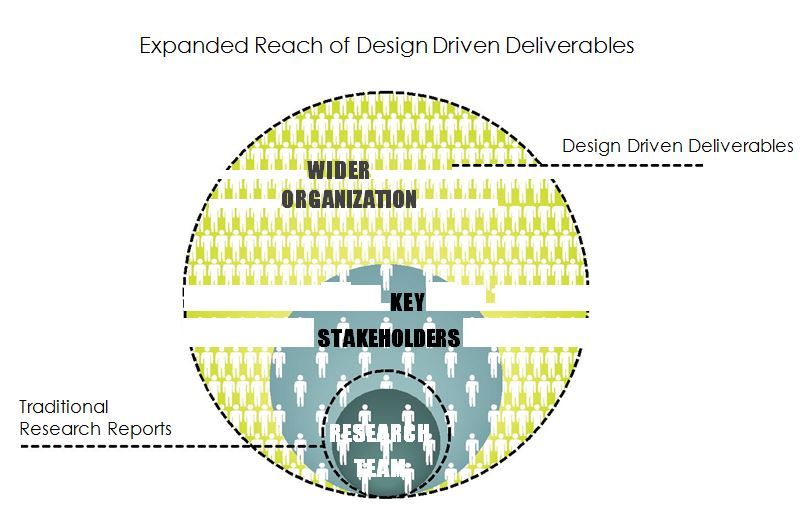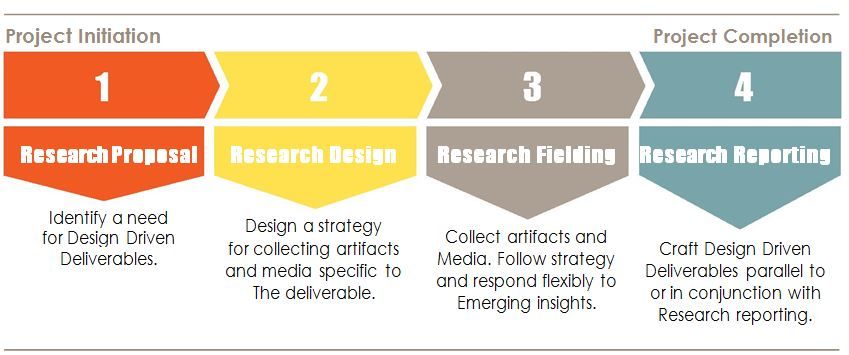Categories
W5 on Design Driven
Making research findings distinct and memorable for your audience can be a challenge. Results are typically presented with slides of bullet points, charts and graphs–flattening findings into a one-size-fits-all format. Good research should capture the richness of human experience and Design Driven Deliverables add dimension to the process through visually engaging, interactive, multi-sensory deliverables. The shift from “reporting” research to “experiencing” it enables your findings to resonate in new and unexpected ways. This white paper provides an overview of Design Driven Deliverables, how they are selected and executed, and how they can best be employed.
What are Design Driven Deliverables?
Most research initiatives culminate in “the standard research report,” filled with research findings, conclusions, and recommendations. It is a valuable part of the research process, serving as a comprehensive account of the research findings. Unfortunately, it is often seen as the end of the research process.
Design Driven Deliverables include any method of communicating research findings that goes beyond the stan-dard research report. They represent an opportunity to amplify the effect of a research initiative through the use of interactive and multisensory approaches to reporting, bringing the audience closer to the research and engaging them in unexpected ways. They address those particular circumstances where traditional reporting is unable to truly convey the richness and meaning of the research. Ultimately, Design Driven Deliverables comple-ment the traditional research report, finding new ways to shed light on key insights.
Why use Design Driven Deliverables?
No matter how insightful and well-crafted a traditional research report may be, the nature of the format lends itself to being read a handful of times, at best, and set aside. Design Driven Deliverables can aid in extending the lifespan of the research, rendering it an integral part of strategic initiatives.
Part of the value of Design Driven Deliverables is their ability to engage the audience beyond simply reading a research report. Traditional research reports require the audience to read, comprehend, and remember key elements of the research. Design Driven Deliverables work as a sort of shorthand. They engage the senses, inspiring readers to contemplate the research rather than labor over it. While printed words on a page may be ideal in some circumstances, visually engaging, interactive, and multisensory deliverables are often better suited to convey research findings.

Ultimately, what we see is a shift from the traditional research report, requiring the audience to read a docu-ment, to Design Driven Deliverables that can engage an audience in an interactive and multisensory manner.
Design Driven Deliverables are also adept at bringing the lifestyle of the consumer to the fore. So often, the richness of the research process is flattened and compressed in the context of the traditional research report. While this is especially true regarding qualitative research, quantitative approaches to consumer understand-ing such as segmentation can also be brought to life using Design Driven Deliverables. Many of the various Design Driven Deliverable tactics use visual documentation and physical artifacts, culled directly from the research process. The ability to visualize the life of the consumer, rather than just explain it, is vital. Likewise, Design Driven Deliverables are able to help communicate even the most abstract and conceptual research insights and findings.
Types of Design Driven Deliverables
From small printed matter to immersion rooms and installations, Design Driven Deliverables come in all shapes and sizes. The broad range of media used to convey research findings provide an opportunity to suit the project at hand, using careful selection of media and appropriate combination of elements.
Generally, each of the varied types of deliverable falls into one of the following categories:
It is important to note that while many of these media are physical and tactile in nature, others can be executed in a digital or online setting. Graphic, Sensory, Experiential, and Installation-based deliverables can be created virtually, allowing access to an audience that exists in multiple locations.
Design Driven Deliverables can be scaled to suit logistic and budgetary constraints. A full-scale installation, filled with ethnographic artifacts, is more expensive to design and execute than a series of postcards highlight-ing key research themes. While Design Driven Deliverables are certainly an added expense beyond the usual engagement fees, this expense can typically be justified based on its effectiveness in extending the reach of the research by making it accessible to a broad audience. As one component of a larger research initiative, Design Driven Deliverables often represent a small fraction of total engagement fees.
The benefits of Design Driven Deliverables
In our experience, Design Driven Deliverables can be used by all types of clients, from ad agencies looking to help their client better understand research insight, to Fortune 500 companies in virtually any industry. Any situation that calls for research insights to serve as references in developing strategy, advertising, or product concepts intended to engage consumers in new and exciting ways can benefit.
Often, research reporting is created by and for other marketing professionals, insiders who understand the language and lexicon of marketing research. However, many business situations are such that other stakehold-ers need to be brought into the research process. If research is to be truly impactful, it needs to be accessible to individuals representing various facets of an organization. Addressing a broader audience and finding new ways for the research to resonate with that audience is the key to the effectiveness of a research initiative. Design Driven Deliverables have the capability to reach a larger audience than traditional research reports.

Yet another benefit of Design Driven Deliverables is their ability to be executed in conjunction with virtually any type of research. Qualitative, quantitative, and hybrid research initiatives are all capable of yielding rich and effective Design Driven Deliverables that extend the reach of the research insights and findings beyond the traditional report.
Qualitative Research
A well-executed Design Driven Deliverable can communicate participants’ experience and lifestyle, beyond the stated facts.
Ethnography
Interacting with participants in the places where they work, eat, sleep and socialize provides the researcher with the opportunity to observe participants in their everyday environment. Capturing the sights, sounds, smells, textures and other non-verbal stimuli in a traditional research report is challenging. Design Driven Deliverables allow for audio, video, and physical artifacts to be included in the research reporting.
Personas
Personas research uses a variety of qualitative approaches to identify idealized or prototypical consumer profiles for future messaging and/or product development. Design Driven Deliverables allow for the personality and lifestyle of the consumer to be presented in a manner that is easily understood by a broad audience.
Quantitative Research
A well-crafted Design Driven Deliverable can communicate richness and engage an audience that may otherwise be left cold by quantitative findings.
Segmentation
While segmentation is a powerful research tool, the details and nuance of its findings can often be lost in a traditional research report. Design Driven Deliverables can begin to bring segments to life, enabling the audience to relate to them on their own terms.
Tracking / A&U Studies
For more traditional quantitative research, Design Driven Deliverables can serve as a convenient way to communicate findings. Providing a quick reference, as opposed to a detailed research report, enables you to reach a wider, non-research audience.
Hybrid Research
Often, hybrid research initiatives result in either a series of reports that document the distinct phases of the research or a single report that segregates the qualitative from the quantitative. While these disparate approaches may align to yield research conclusions and recommendations, well-chosen Design Driven Deliverables can be valuable in communicating research insights that transcend methodology.
What makes a good Design Driven Deliverable?
Design Driven Deliverables come in many shapes and sizes. Custom in nature, simply selecting the type of Design Driven Deliverable (Graphic, Sensory, Experiential, Installation-based) becomes a task worthy of con-templation. There are three main considerations when executing a Design Driven Deliverable: process, context, and content.
1. Process
In our experience, Design Driven Deliverables are best executed when they are included as a part of the research design process. Beginning with the development of a research proposal, the possibility of a deliverable beyond the traditional research report is best encompassed into the research itself. This is especially true of more complex deliverables that involve the collection of specific types of data, including video, audio, photographic, and physical artifacts. While attempts to replicate and collect such items after the fieldwork has ceased is possible, it is likely that they will not be quite as rich as had they been gathered during the research process.
Typically, integration of Design Driven Deliverables into the research process is as follows:

While this process is not applicable to all types of engagements, it is certainly the case with those that are qualitative in nature, particularly ethnographic research. Artifacts such as consumer diaries, collages, and pho-tographs are often used in the creation of such deliverables, and are impossible to truly replicate after fielding has been completed.
While it is entirely possible to craft Design Driven Deliverables in a secondary or post-hoc manner, the creation of such deliverables is a significantly different process. Deliverables crafted in a post-hoc or secondary manner become stand-alone projects, and considerable attention is paid to how best to build a rich and nuanced deliverable from the research data provided. The deliverable itself is a by-product of the richness of the existing research, the nature of the subject matter, and the ability to replicate or interpolate the materials needed to create a strong deliverable.
2. Context
The key to successfully creating a truly engaging deliverable has little to do with the type of research conducted. Rather, a strong Design Driven Deliverable is one that bridges the gap between research insights, intended audience, and strategic business objectives.
The key to creating rich and engaging deliverables is understanding how it will work in context. A Design Driven Deliverable must be selected based on its ability to inspire the audience to continually consider key research insights when working to meet strategic business objectives. Ultimately, it is these strategic business objectives that are of the utmost importance.
3. Content
Selecting the precise type of Design Driven Deliverable is largely about determining the context in which it will operate. Once this context is established, careful consideration of its content and presentation optimizes the effectiveness of a Design Driven Deliverable. Ultimately, a deliverable must be able to communicate effectively with its audience. The following points serve as a brief guide to gauging the effectiveness of a Design Driven Deliverable:

To some extent, these points are common sense. Yet it is important to keep these issues in mind, as they are what make the difference between a truly effective deliverable and one that is little more than window-dressing. It is not about simply drawing attention or making the research “prettier.” Design Driven Deliverables are a communication tool, intended to add value to the research process as a whole.
Incorporating design into the research process
Creating strong Design Driven Deliverables is a complicated task that can benefit from working with researchers who understand the design process as well as professional designers. The skills that a profes - sional designer brings to the process of developing and implementing a Design Driven Deliverable have tremendous impact on its overall effectiveness. An experienced designer is able to work carefully and with great detail to properly align a deliverable with the expectations of a particular audience and the strate - gic objective at hand.
Along with being a trusted research and strategy partner, W5 has expertise in developing effective Design Driven Deliverables. Contact us to discuss how to best integrate Design Driven Deliverables into your next research engagement
This content was originally published by W5 . Visit their website at www.W5insight.com.
Sign Up for
Updates
Get content that matters, written by top insights industry experts, delivered right to your inbox.




